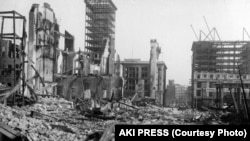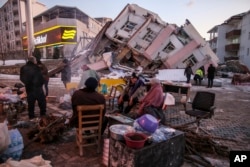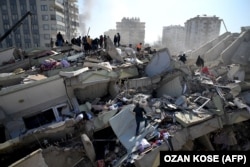ALMATY, Kazakhstan -- Janyl Tokoeva was asleep in her apartment in the Turkish town of Kahramanmaras when her fluffy white cat began meowing loudly.
It was a little after 4 a.m. on February 6, and the Kyrgyz citizen could not yet feel the tremors of the earthquake that would soon devastate parts of Turkey and Syria, leaving more than 24,000 dead and counting.
But she trusted her frantic pet’s sixth sense.
Tokoeva scooped up the animal and ran outside, knocking on neighbors’ doors as she went. The earth began to shake just as she left the building.
“We did not know where to go, and we walked the streets until lunch. It was raining. We went to one place and saw a building collapse, walked farther and saw another collapse,” she told RFE/RL’s Kyrgyz Service in an interview from a hydroelectric power station where survivors of the 7.8-magnitude quake were sheltering with inadequate food supplies.
“As we were walking, the second earthquake struck -- [it felt] the strongest. I could not stay on my feet. Buildings that survived the first tremors began to fall,” Tokoeva recalled.
In Central Asia, accounts such as Tokoeva’s and distressing images of children -- dead and alive -- being pulled from the rubble have helped power donation drives, especially for Turkey, where all five governments of the region have sent search-and-rescue teams.
But the images have also triggered discussions about how Central Asian cities in seismically active zones might respond to similar destruction, with cities like Almaty -- Kazakhstan’s largest city -- and the Uzbek and Turkmen capitals, Tashkent and Ashgabat, all experiencing major earthquakes in the last century.
“Many multistory buildings have popped up in Osh and [the capital] Bishkek [in recent years], like mushrooms after the rain,” complained Meder Aliev, a Kyrgyz lawmaker, referring to the country’s two largest cities.
“They were built on both licensed and unlicensed land,” he added. “What is their quality? Do they meet safety requirements? If there is an earthquake, what magnitude would they withstand? We need to investigate all this urgently.”
Warnings From History
Although pervasive state censorship during the Soviet period makes it impossible to know how many people died, the 7.3-magnitude earthquake that struck Ashgabat in 1948 likely killed tens of thousands, including the mother of the country’s first postindependence president, Saparmurat Niyazov.
The 1966 earthquake in Tashkent was far less deadly but still leveled whole parts of the region’s most populous city.
Almaty -- then called Verny and with less than one-tenth of its present 1.8 million population -- was all but destroyed by a 1911 quake that had its epicenter in modern-day Kyrgyzstan, following two other powerful quakes in that region in the late 19th century.
Since gaining independence in 1991, Central Asian countries have endured less significant tremors, although a 6.6-magnitude quake in 2008 with an epicenter near the Chinese, Kyrgyz, and Tajik borders destroyed the village of Nura in Kyrgyzstan, killing more than 70 people.
In the days since the quake hit Syria and Turkey, experts at state seismological institutes in Central Asian countries have been regularly quoted in the press. They have invariably trotted out the oft-repeated line that buildings are supposed to be built to resist earthquakes up to magnitude 9 (in elevated parts of Almaty, the standard is 10).
But there have long been concerns that these rules are not enforced as they were in Soviet times, when buildings in seismically active regions were typically always the same preapproved type.
Rustam Mukimov, an architect in the Tajik capital, Dushanbe, told RFE/RL’s Tajik Service that in the communist era new housing models were tested at a special site outside the city.
“They tested the walls and roof of the building with special tools. There was a test. They don't make them like that anymore. I think they don't have enough money,” he said.
Concerns have been heightened by sudden building sprees in large cities, such as the one after Kyrgyzstan’s 2010 revolution and in Uzbekistan in 2016 when Shavkat Mirziyoev became president.
Two days after the quake in the Middle East, Mirziyoev ordered a freeze on construction in Tashkent in an announcement that cited the need to wait for a new city plan while ignoring any mention of the cataclysm in the Middle East.
The day before, the country’s deputy construction minister had sparked criticism with comments that suggested the government was not entirely responsible for ensuring building safety.
“The main body responsible for construction work is the one that commissioned it -- that is, the owner of the building,” said Deputy Minister Davronzhon Adilov.
Adilov said he could provide guarantees for “the control, implemented order, rules, and standards established by the state” but not for “human error.”
The mayor who oversaw the best part of Tashkent’s recent building boom, Jahongir Ortikhodjaev, was fired in January by Mirziyoev as swathes of the capital endured long power cuts during Uzbekistan’s coldest winter in many years.
Reports that he was detained while attempting to leave the country with his family have not been confirmed.
Home Away From Home
Had it been another country so badly affected by the earthquake, these discussions might not have acquired such urgency. Hundreds of thousands of Central Asians live and work in Turkey, making it the second-biggest destination for labor migration outside the region, after Russia.
At least one Uzbek citizen and two citizens of Kazakhstan are known to have died, while others are among the missing.
In an interview with RFE/RL’s Turkmen Service, Turkmen Maryemgul Baimyradova called on her country’s secretive government to clarify the well-being of Turkmen being held in migrant deportation centers in Adana and Malatya, two Turkish provinces which, along with the epicenter, Kahramanmaras, have seen colossal damage done to them.
“Take care of your citizens!” Baimyradova demanded of her government.
In a rare admission on February 8, Gurbanguly Berdymukhammedov, the former Turkmen president and official “leader of the nation,” acknowledged that Turkmen had suffered in the quake, without offering details.
The dissident-run, Europe-based Turkmen News reported the death and repatriation by the Turkmen government of four Turkmen.
Scores of rescue workers from the five countries have arrived in Turkey in recent days, officials say, and tons of humanitarian aid have been sent from Central Asia.
In addition to state-led assistance, there have also been many grassroots efforts to collect aid.
In Kazakhstan, one group of women is aiming to sew 4,000 blankets to send to the country, and a local businessman has pledged to send 120 yurts for people who lost their homes in the earthquakes.
But for Central Asians, the image of a country thrown into disarray and relying on humanitarian assistance from at least 70 countries has been a jarring one for people who view Turkey as a strong trade partner and important foreign investor, not to mention a major presence in local construction.
Nursarsen Uzbekov, the deputy director of the seismological institute under the Kazakh Emergencies Ministry, told RFE/RL that the specific nature of the East Anatolian Fault made a “catastrophic” earthquake more likely in southeastern Turkey than in Kazakhstan.
The expert also expressed confidence in the ongoing development of early warning systems in Central Asia’s richest city, Almaty, and the strict following of building standards.
“I cannot comment on whether building standards were adhered to in Turkey. It is an unknown for us,” Uzbekov said. “But if a giant earthquake like the earthquakes of the late 19th century were to occur here, God forbid, I think we would look first of all to our own resources [to deal with it]. If we couldn’t, then, like Turkey, we have good partners who would be ready to assist us.”














